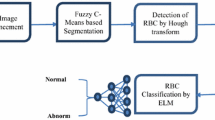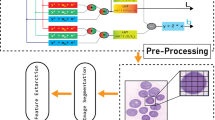Abstract
The analysis of pathophysiological change to erythrocytes is important for early diagnosis of anaemia. The manual assessment of pathology slides is time-consuming and complicated regarding various types of cell identification. This paper proposes an ensemble rule-based decision-making approach for morphological classification of erythrocytes. Firstly, the digital microscopic blood smear images are pre-processed for removal of spurious regions followed by colour normalisation and thresholding. The erythrocytes are segmented from background image using the watershed algorithm. The shape features are then extracted from the segmented image to detect shape abnormality present in microscopic blood smear images. The decision about the abnormality is taken using proposed multiple rule-based expert systems. The deciding factor is majority ensemble voting for abnormally shaped erythrocytes. Here, shape-based features are considered for nine different types of abnormal erythrocytes including normal erythrocytes. Further, the adaptive boosting algorithm is used to generate multiple decision tree models where each model tree generates an individual rule set. The supervised classification method is followed to generate rules using a C4.5 decision tree. The proposed ensemble approach is precise in detecting eight types of abnormal erythrocytes with an overall accuracy of 97.81% and weighted sensitivity of 97.33%, weighted specificity of 99.7%, and weighted precision of 98%. This approach shows the robustness of proposed strategy for erythrocytes classification into abnormal and normal class. The article also clarifies its latent quality to be incorporated in point of care technology solution targeting a rapid clinical assistance.









Similar content being viewed by others
References
National Family Health Survey (NFHS-3). Mumbai IIPS, 2007.
Gragnolati, M., Shekar. M., Gupta, M. D., Bredenkamp, C., and Lee, Y. K., India's undernourished children: a call for reform and action. World Bank Publications. Washington, DC, 2005.
Ćosić, D., and Lončarić, S., Rule-based labeling of CT head image. In: Artificial Intelligence in Medicine. Springer, pp. 453–456, 1997.
Cunningham, P., Carney, J., and Jacob, S., Stability problems with artificial neural networks and the ensemble solution. Artif. Intell. Med. 20(3):217–225, 2000.
Zhou, Z.-H., and Jiang, Y., Medical diagnosis with C4. 5 rule preceded by artificial neural network ensemble. IEEE Trans. Inf. Technol. Biomed. 7(1):37–42, 2003.
Liao, S.-H., Expert system methodologies and applications—a decade review from 1995 to 2004. Expert Syst. Appl. 28(1):93–103, 2005.
Birndorf, N.I., Pentecost, J.O., Coakley, J.R., and Spackman, K.A., An expert system to diagnose anemia and report results directly on hematology forms. Comput. Biomed. Res. 29(1):16–26, 1996.
Li, D., Fu, Z., and Duan, Y., Fish-expert: a web-based expert system for fish disease diagnosis. Expert Syst. Appl. 23(3):311–320, 2002.
Mangalampalli, A., Mangalampalli, S.M., Chakravarthy, R., and Jain, A.K., A neural network based clinical decision-support system for efficient diagnosis and fuzzy-based prescription of gynecological diseases using homoeopathic medicinal system. Expert Syst. Appl. 30(1):109–116, 2006.
Pal, D., Mandana, K., Pal, S., Sarkar, D., and Chakraborty, C., Fuzzy expert system approach for coronary artery disease screening using clinical parameters. Knowl.-Based Syst. 36:162–174, 2012.
Khachane, M. Y., Manza, R., and Ramteke, R., Fuzzy rule based classification of human spermatozoa. In: International Conference on Electrical, Electronics, Signals, Communication and Optimization. IEEE, pp. 1–5, 2015.
Taher, F., Werghi, N., and Al-Ahmad, H., Rule based classification of sputum images for early lung cancer detection. In: IEEE International Conference on Electronics, Circuits, and Systems. IEEE, pp. 29–32, 2015.
Sanz, J.A., Galar, M., Jurio, A., Brugos, A., Pagola, M., and Bustince, H., Medical diagnosis of cardiovascular diseases using an interval-valued fuzzy rule-based classification system. Appl. Soft Comput. 20:103–111, 2014.
Chaves, R., Ramírez, J., Gorriz, J., and Initiative, A.D.N., Integrating discretization and association rule-based classification for Alzheimer’s disease diagnosis. Expert Syst. Appl. 40(5):1571–1578, 2013.
Antonie, M.-L., Zaiane, O. R., and Coman, A., Associative classifiers for medical images. In: Pacific-Asia Conference on Knowledge Discovery and Data Mining. Springer, pp. 68–83, 2002.
Friedman, E.A., Computer-assisted medical diagnosis for rural sub-Saharan Africa. IEEE Technol. Soc. Mag. 28(3):18–27, 2009.
Yang, L., Tuzel, O., Chen, W., Meer, P., Salaru, G., Goodell, L.A., and Foran, D.J., Pathminer: a web-based tool for computer-assisted diagnostics in pathology. IEEE Trans. Inf. Technol. Biomed. 13(3):291–299, 2009.
Frejlichowski, D., Identification of erythrocyte types in greyscale MGG images for computer-assisted diagnosis. In: Pattern Recognition and Image Analysis. Springer, pp. 636–643, 2011.
Das, D., Ghosh, M., Chakraborty, C., Pal, M., and Maity, A., Invariant moment based feature analysis for abnormal erythrocyte recognition. In: International Conference on Systems in Medicine and Biology. IEEE, pp. 242–247, 2010.
Maity, M., Sarkar, P., and Chakraborty, C., Computer-assisted approach to anemic erythrocyte classification using blood pathological information. In: International Conference on Emerging Applications of Information Technology. IEEE, pp. 116–121, 2012.
Chen, H.-M., Tsao, Y.-T., and Tsai, S.-N., Automatic image segmentation and classification based on direction texton technique for hemolytic anemia in thin blood smears. Mach. Vis. Appl. 25(2):501–510, 2014.
Akrimi, J. A., Suliman, A., George, L. E., and Ahmad, A. R., Classification red blood cells using support vector machine. In: International Conference on Information Technology and Multimedia. IEEE, pp. 265–269, 2014.
Bhowmick, S., Das, D.K., Maiti, A.K., and Chakraborty, C., Structural and textural classification of erythrocytes in anaemic cases: a scanning electron microscopic study. Micron. 44:384–394, 2013.
Veluchamy, M., Perumal, K., and Ponuchamy, T., Feature extraction and classification of blood cells using artificial neural network. Am. J. Appl. Sci. 9(5):615, 2012.
Tomari, R., Zakaria, W.N.W., Jamil, M.M.A., Nor, F.M., and Fuad, N.F.N., Computer aided system for red blood cell classification in blood smear image. Procedia Computer Science. 42:206–213, 2014.
Deb, N., and Chakraborty, S., A noble technique for detecting anemia through classification of red blood cells in blood smear. In: Recent Advances and Innovations in Engineering (ICRAIE). IEEE, pp. 1–9, 2014.
Lotfi, M., Nazari, B., Sadri, S., and Sichani, N. K., The Detection Of Dacrocyte, Schistocyte and Elliptocyte cells in Iron Deficiency Anemia. In: International Conference on Pattern Recognition and Image Analysis. IEEE, pp. 1–5, 2015.
Markiewicz, T., Osowski, S., Marianska, B., and Moszczynski, L., Automatic recognition of the blood cells of myelogenous leukemia using SVM. In: Proceedings of IEEE International Joint Conference on Neural Networks. IEEE, pp. 2496–2501, 2005.
Park, H.S., Rinehart, M.T., Walzer, K.A., Chi, J.-T.A., and Wax, A., Automated Detection of P. falciparum using machine learning algorithms with quantitative phase images of unstained cells. PLoS One. 11(9):e0163045, 2016.
Rasband, W., ImageJ: image processing and analysis in java. Astrophysics Source Code Library. 1:06013, 2012.
Hall, M., Frank, E., Holmes, G., Pfahringer, B., Reutemann, P., and Witten, I.H., The WEKA data mining software: an update. ACM SIGKDD Explorations Newsletter. 11(1):10–18, 2009.
Friedman-Hill, E., JESS in action. Manning, Greenwich, 2003.
Das, D. K., Abnormal erythrocyte recognition uisng microscopic images of peripheral blood smears. Indian Institute of Technology Kharagpur, 2012.
Zuiderveld, K., Contrast limited adaptive histogram equalization. In: Graphics gems IV. Academic Press Professional, Inc., pp. 474–485, 1994.
Gonzalez, R.C., Woods, R.E., and Eddins, S.L., Digital image processing using MATLAB. Pearson Prentice Hall, Upper Saddle River, 2004.
Rrnyi, A., On measures of entropy and information. In: Fourth Berkeley Symposium on Mathematical Statistics and Probability. pp. 547–561, 1961.
Quinlan, J.R., Induction of decision trees. Mach. Learn. 1(1):81–106, 1986.
Witten, I. H., Frank, E., Data Mining: Practical machine learning tools and techniques. Morgan Kaufmann, 2005.
Freund, Y., Schapire, R., and Abe, N., A short introduction to boosting. Japanese Society For Artificial Intelligence. 14(771–780):1612, 1999.
Zhou, Z. H., Ensemble methods: foundations and algorithms. CRC Press, Boca Raton, 2012.
Friedman, J.H., and Popescu, B.E., Predictive learning via rule ensembles. Ann. Appl. Stat. 2(3):916–954, 2008.
Opitz, D., and Maclin, R., Popular ensemble methods: an empirical study. J. Artif. Intell. Res. 11:169–198, 1999.
Polikar, R., Ensemble based systems in decision making. IEEE Circuits Syst. Mag. 6(3):21–45, 2006.
Rokach, L., Ensemble-based classifiers. Artif. Intell. Rev. 33(1–2):1–39, 2010.
Forgy, C. L., Rete: a fast algorithm for the many pattern/many object pattern match problem. In: Peter, G. R., (Ed.), Expert systems. IEEE Computer Society Press, pp. 324–341, 1990.
Wheeless, L.L., Robinson, R.D., Lapets, O.P., Cox, C., Rubio, A., Weintraub, M., and Benjamin, L.J., Classification of red blood cells as normal, sickle, or other abnormal, using a single image analysis feature. Cytometry. 17(2):159–166, 1994.
Acknowledgement
The first author acknowledges the Council of Scientific and Industrial Research for providing financial support to carry out this research work under the award no. 09/81(1223)/2014/EMR-I dt. 12-08-2014. The corresponding author acknowledges the Microsoft Research, Bangalore, India for partial financial support [Grant Ref. No. IIT/SRIC/SMST/IWM/2014-15/88].
Author information
Authors and Affiliations
Corresponding author
Additional information
This article is part of the Topical Collection on Image & Signal Processing
Rights and permissions
About this article
Cite this article
Maity, M., Mungle, T., Dhane, D. et al. An Ensemble Rule Learning Approach for Automated Morphological Classification of Erythrocytes. J Med Syst 41, 56 (2017). https://doi.org/10.1007/s10916-017-0691-x
Received:
Accepted:
Published:
DOI: https://doi.org/10.1007/s10916-017-0691-x




